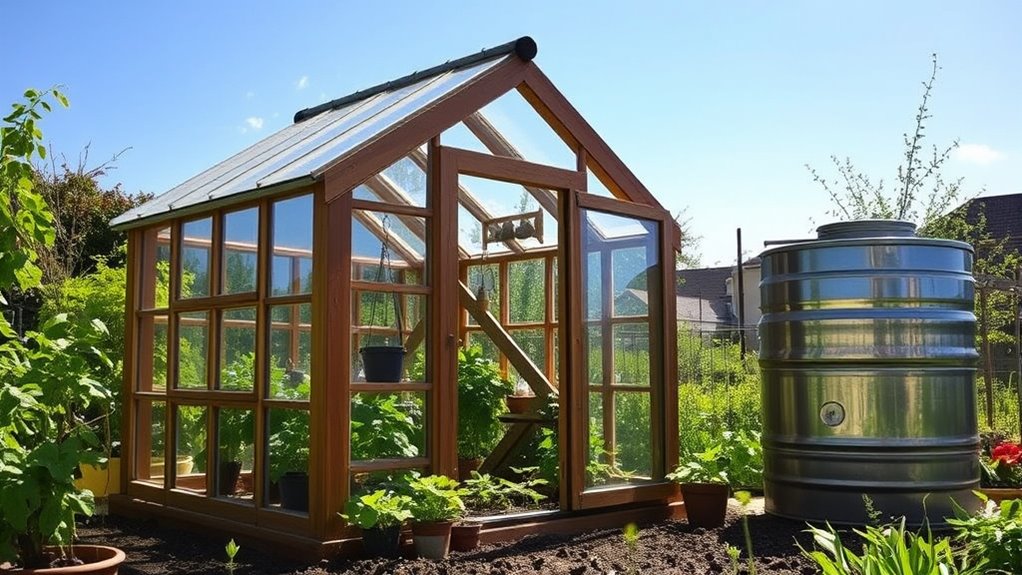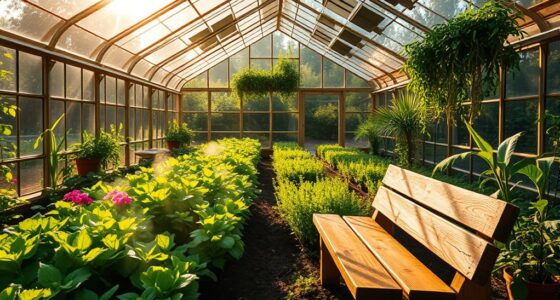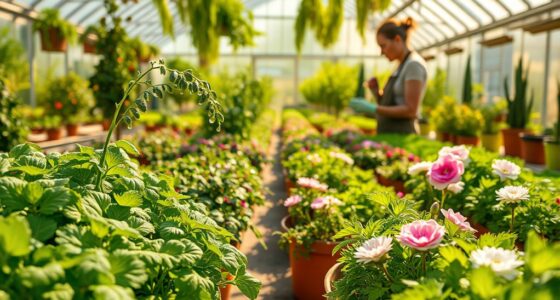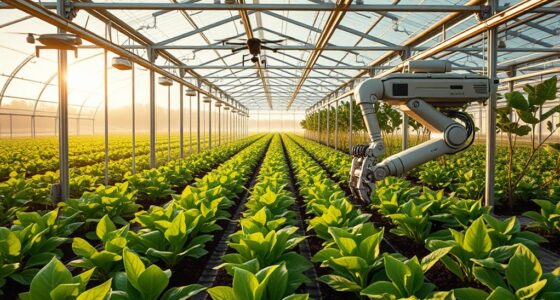To build a DIY sustainable greenhouse, start by choosing eco-friendly materials like recycled plastics or reclaimed wood. Use energy-efficient strategies such as solar panels and good insulation to keep temperatures stable. Incorporate water conservation methods like rainwater harvesting. Design for durability by positioning your greenhouse for maximum sunlight and ensuring proper ventilation. By focusing on these aspects, you’ll create a functional, eco-friendly space. Keep going if you want more tips on fostering sustainability!
Key Takeaways
- Utilize recycled materials or sustainably sourced wood to create a durable and eco-friendly greenhouse structure.
- Incorporate solar panels for renewable energy and reduce electricity costs for lighting and systems.
- Design the greenhouse to maximize sunlight exposure by positioning it south-facing and using energy-efficient glazing.
- Implement natural ventilation methods like roof vents and sidewall curtains to maintain temperature and reduce energy usage.
- Consider rainwater harvesting systems to conserve water and efficiently manage irrigation needs.
Choosing Sustainable Materials
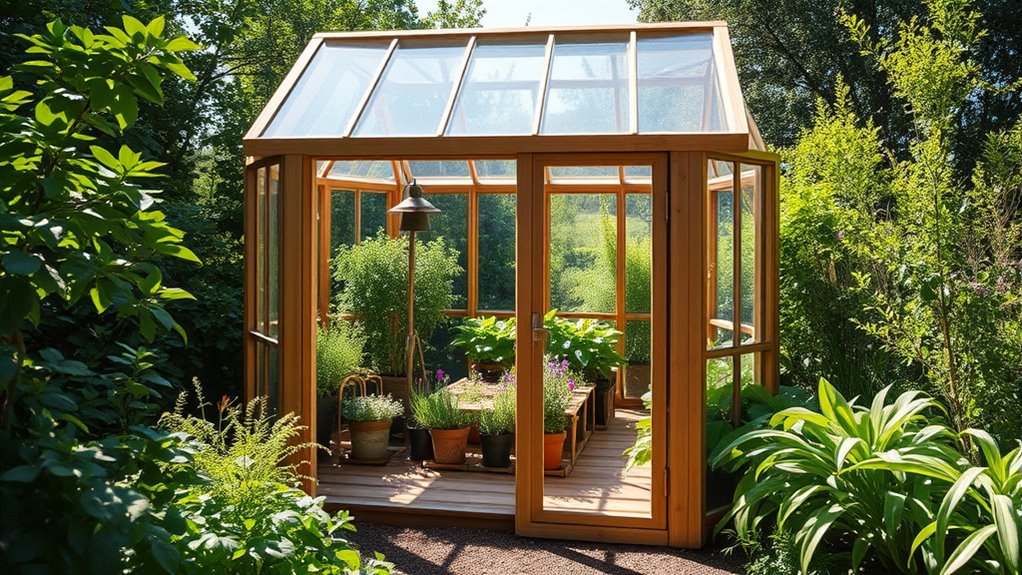
When you’re building a sustainable greenhouse, choosing the right materials is essential for both the environment and your budget.
Start with recycled materials like plastic panels, which are durable and offer excellent insulation. Sustainable wood, such as reclaimed or sustainably harvested options, not only looks great but also reduces the demand for new lumber. Additionally, local climate should be considered when selecting these materials to ensure optimal durability and insulation. Using renewable resources like wood can enhance the sustainability of your greenhouse project. Chia seeds, known for their high nutritional value, can also be grown in a greenhouse, promoting a seed-based diet. Understanding legalities around the construction of your greenhouse can further ensure compliance with local regulations.
Consider bamboo for frameworks; it’s fast-growing and strong. Eco-friendly glass, particularly if sourced from recycled materials, can enhance energy efficiency.
Metal frames, especially aluminum and galvanized steel, provide durability and can often be recycled.
Implementing Energy Efficiency Strategies
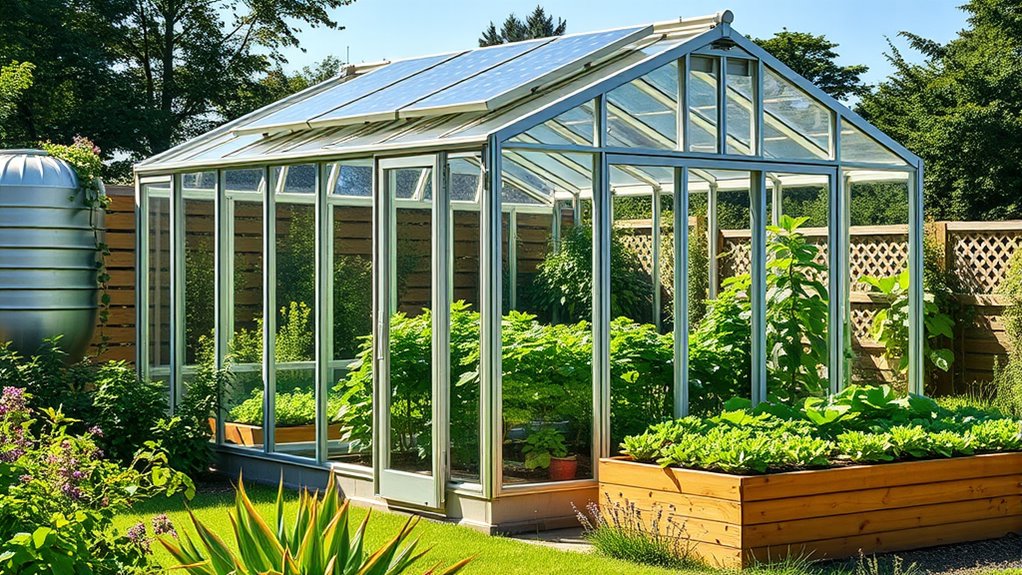
Building a sustainable greenhouse doesn’t stop at selecting the right materials; it also involves implementing energy efficiency strategies to maximize your greenhouse’s performance.
Start by integrating solar panels or wind turbines to harness renewable energy. Consider biomass systems for heating and electricity, or install heat pumps and geothermal systems for efficient temperature control. Heat pumps can reduce energy consumption by up to 50%, leading to significant cost savings on utility bills. Understanding the refrigeration cycle in heat pumps will aid in optimizing their performance. Geothermal heat pumps achieve efficiency ratings of 300% to 600%, making them a highly effective option for temperature regulation.
Integrate renewable energy sources like solar panels and wind turbines for efficient heating and temperature control in your greenhouse.
Enhance ventilation by using natural methods and high-efficiency fans, and incorporate thermal mass materials to stabilize temperatures. Leaky greenhouses allow cold air in and warm air out, so improving insulation with double-glazed windows and insulated walls will minimize heat loss.
Optimize your lighting by switching to LED systems and utilizing automated controls. Regular energy audits will help you identify further improvements, ensuring your greenhouse remains energy-efficient and sustainable.
Adopting Sustainable Practices

To create a truly sustainable greenhouse, you’ll want to adopt a range of eco-friendly practices that enhance efficiency and support the environment.
Start by using recycled or sustainably sourced materials like reclaimed wood and bamboo for construction. Opt for energy-efficient glazing options, such as polycarbonate panels, to improve insulation. Incorporating solar energy solutions can also provide electricity for lighting and small appliances, enhancing the greenhouse’s sustainability. Additionally, utilizing solar panels can help power your greenhouse, ensuring energy independence and reducing reliance on traditional energy sources. Consider installing best waterwick pots to maintain consistent moisture levels for your plants, further promoting their health and growth.
Implement water conservation methods, like rainwater harvesting and drip irrigation systems, to reduce water waste. Enhance soil health through composting and organic fertilizers while practicing crop rotation. Additionally, consider incorporating passive solar design features to maximize energy efficiency and reduce heating costs.
Promote biodiversity with companion planting and pollinator-friendly plants. Finally, engage your community by sharing surplus produce and hosting workshops to inspire sustainable practices.
Designing for Functionality and Durability
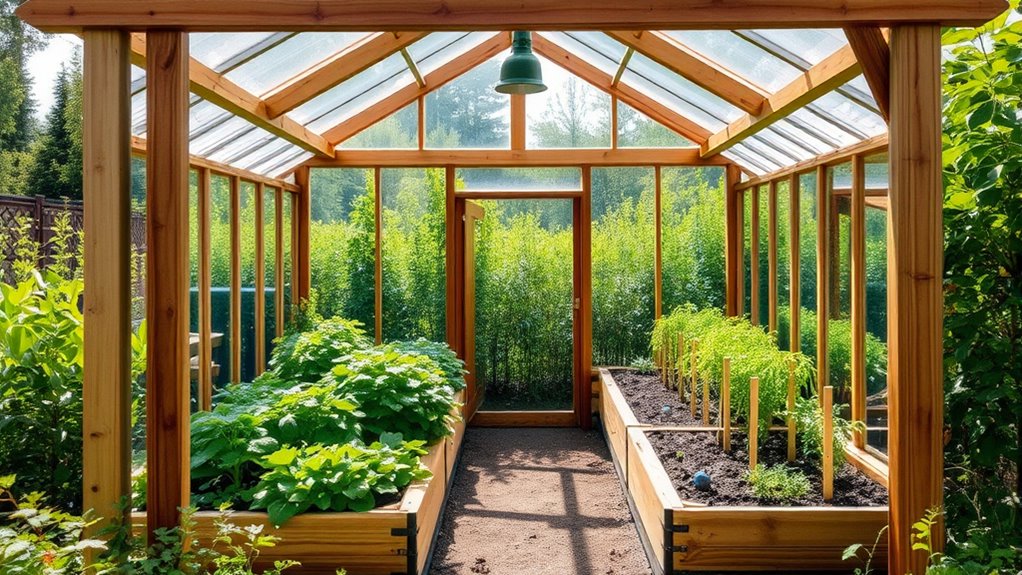
Integrating sustainable practices sets a solid foundation for your greenhouse, but functionality and durability are what keep it thriving through various challenges.
Start by positioning your greenhouse south-facing to maximize sunlight and reduce lighting needs. Insulate the north wall and sidewalls to maintain stable temperatures. Incorporate thermal mass materials like concrete to stabilize heat, ensuring that the ground acts as a critical fifth plane in your design.
Use natural ventilation with roof vents and sidewall curtains to minimize electricity use. When selecting materials, choose reclaimed wood, eco-friendly glazing, and durable frames, ensuring they withstand weather extremes.
A strong foundation is essential for longevity, while regular maintenance keeps everything in top shape.
Design adaptability for future modifications will enhance functionality, making your greenhouse a resilient, productive space for years to come.
Understanding Cost and Environmental Impact
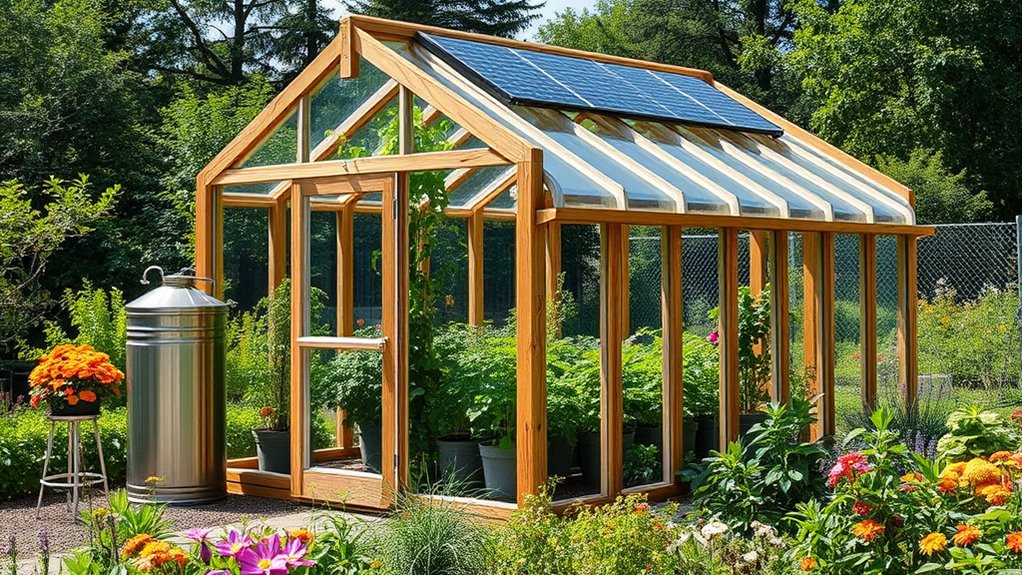
While considering a DIY sustainable greenhouse, it’s crucial to weigh both the initial costs and the long-term environmental impact.
Startup costs can range from a few hundred to several thousand dollars, depending on materials and size. Using reclaimed wood or bamboo can lower expenses and reduce environmental harm. Additionally, proper placement of your greenhouse with an east-west orientation can maximize sunlight and improve energy efficiency. A well-designed greenhouse can also extend your gardening season significantly. Implementing strategies from an energy efficiency evaluation can further optimize your greenhouse’s performance. It’s important to consider local building codes to ensure your greenhouse meets any necessary regulations.
Incorporating solar panels and rainwater systems enhances energy efficiency and conserves water. Remember, DIY construction demands time and effort, so factor in labor and tool costs. Buying materials in bulk or repurposing items can further save money.
While upfront costs for pre-built greenhouses may be higher, they often offer durability and lower maintenance, making them a worthy investment in the long run.
Choose wisely for both your wallet and the planet!
Frequently Asked Questions
How Long Does It Take to Build a DIY Greenhouse?
Building a greenhouse can take anywhere from a couple of days to several weeks, depending on your design’s complexity and the help you have.
If you stick with a simple design, you might finish in just two days. However, if you opt for something more intricate, like a concrete foundation, expect it to take longer.
Keep in mind that factors like weather and your skill level will also influence how long it takes.
What Tools Are Needed for Constructing a Greenhouse?
Building a greenhouse is like crafting a cozy shelter for plants; you’ll need the right tools to make it happen.
Start with basic construction tools like a circular saw and drill driver combo. Add specialized tools like a flush cut saw and nail gun for precision.
Don’t forget measuring tools like a tape measure and safety gear. With these essentials, you’ll be well-equipped to create your green haven!
Can I Use Reclaimed Materials From Old Structures?
Absolutely, you can use reclaimed materials from old structures!
Sourcing materials like old windows, wooden pallets, or salvaged doors not only saves money but also contributes to sustainability.
Check local building sites, community networks, and online platforms to find these treasures.
Just make certain the materials are structurally sound and free from pests.
With a bit of creativity, you can create something unique while minimizing waste and supporting eco-friendly practices.
How Do I Maintain My Greenhouse Year-Round?
Did you know that proper greenhouse maintenance can increase your yield by up to 40%?
To maintain your greenhouse year-round, keep it clean and sanitize surfaces regularly to prevent disease.
Check insulation and guarantee your heating system runs efficiently.
Adjust ventilation as temperatures change, and inspect irrigation systems for leaks.
What Plants Thrive Best in a DIY Greenhouse?
If you’re looking to maximize your greenhouse’s potential, consider plants like tomatoes, bell peppers, and leafy greens that thrive in controlled environments.
Citrus and ginger flourish, too, making them great choices for year-round growth.
For ornamental options, try tulips and orchids, which enjoy the humidity and light.
Don’t forget about herbs; they provide fresh flavors throughout the year.
With careful selection, you’ll create a vibrant, productive greenhouse garden.
Conclusion
By building your DIY sustainable greenhouse with eco-friendly materials and energy-efficient strategies, you’re not just creating a space for vibrant plants to thrive; you’re cultivating a green sanctuary. Picture a sun-drenched haven, where fresh herbs and colorful blooms flourish, all while you reduce your carbon footprint. Embrace sustainable practices and design with longevity in mind, and soon you’ll see your garden flourishing, reflecting your commitment to the planet and creating a beautiful, harmonious environment.
